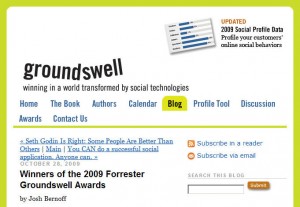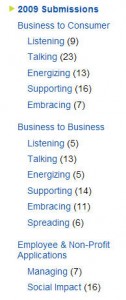If you haven’t heard of the Groundswell Awards—not to worry. It appears this is just the third year for the fairly small competition, sponsored by Forrester via the Groundswell weblog which apparently spins off the book named Groundswell (stick with me here) by Forrester analyst Josh Bernoff and consultant Charlene Li. Everything I know about the awards I learned from reading the Forrester Groundswell Awards Rules, which says:
“Entries should represent excellent and effective use of social technologies to advance an organizational or corporate goal.”
Sounds good! And there is a recruiting-related category in the awards, which we’ll get to in a minute. But first, here’s what especially interested me about the Groundswells: (a) the structure of categories, and (b) the proportionality of the submissions.
Submitters have to choose a category that best fits what they see as the strength of their submission. The categories loosely parallel the ideas in the book, and they go like this:
Listening. Find out what customers are really saying in order to understand them better.
Talking. Spread messages about a company.
Energizing. Get a company’s best customers to evangelize its products.
Spreading. Get customers or users within a company to encourage others to adopt a product or service. (B2B only.)
Supporting. Help customers support each other to solve each other’s problems.
Embracing. Integrate customers into the way a business works, including using their help to design products and improve processes.
Managing. Empower employees and managers within an organization.
Social Impact. Improve society with non-commercial applications.
Even apart from the social media component, this list strikes me as a pretty good anatomy of all the things a corporate Careers site needs to do. Just put “visitors/prospects/applicants/candidates” after each verb, and you would have a fine strategic outline. That is—“Listening to visitors,” “Energizing prospects,” “Embracing candidates,” “Managing applicants,” and so on. (Social Impact applies via messaging about corporate responsibility, green-ness, etc.)
Now for proportionality. Groundswell helpfully offers mini-views of all the submissions, so we know how many submitters put themselves in each category. Just guess which Business-to-Consumer category had the most entrants by far . . . .
That’s right. TALKING.
In spite of all the wisdom out there about listening, most companies are still focused on pushing the message. Business-to-Business was more evenly distributed—but showed even less interest in Listening than the B2Cs. Here’s the Groundswell breakout:
Topic to consider: Does your company’s Careers site have a listening component? How hard would visitors have to look to find the listening component?
The Groundswell award for something to do with employees is (somewhat oddly) Managing, and for some reason, it’s bundled up with non-profits. But in any case—this year’s winner is UPSjobs Problem Solved, “a ‘spreadable’ social media campaign to efficiently and more cost-effectively attract, engage, and recruit jobseekers.”
But I found one of the other entrants especially interesting: The Employee First campaign at India’s HCL Technologies, where “all 55,000 employees of HCL Technologies are given intranet access allowing them to read the reviews of HCL’s CEO Vineet Nayar and the company’s top 20 managers.”
Stop by the HCL Careers site to read more about Employee First, and the “Five Fold Path to Individual Enlightenment.” Very interesting.
Cynthia Giles has followed a serpentine career path from academia to publishing to marketing and design to information technology and corporate communications. There’s plenty of detail about this journey at www.cynthiagiles.com, but briefly--the common theme has been ideas, and how to present them effectively. Along the way, she became an accidental expert on data warehousing and business intelligence, and for the past ten years she has combined corporate contracting with an independent consulting practice that focuses on marketing strategy for smaller businesses and non-profits.
Having spent quite a bit of time looking for work, and anywhere from two weeks to two years inside a wide variety of American companies—she has given much thought to what works (and what doesn’t) when it comes to creating a great employment fit.

